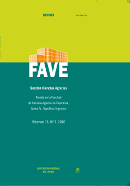Ver ítem
- xmlui.general.dspace_homeCentros Regionales y EEAsCentro Regional Santa FeEEA ReconquistaArtículos científicosxmlui.ArtifactBrowser.ItemViewer.trail
- Inicio
- Centros Regionales y EEAs
- Centro Regional Santa Fe
- EEA Reconquista
- Artículos científicos
- Ver ítem
Aguadas para ganadería bovina en los bajos submeridionales y áreas de influencia
Resumen
En el norte de la provincia de Santa Fe, especialmente en la Cuña Boscosa, Bajos Submeridionales
y Domo Occidental, se encuentran más de tres millones de cabezas de ganado vacuno,
donde uno de los principales condicionantes en la producción es la irregular calidad del
agua subterránea para el abrevado de la hacienda. La fl uctuación entre escenarios hidrológicos
secos y húmedos repercute directamente en la producción, donde no solo varía el nivel
[ver mas...]
En el norte de la provincia de Santa Fe, especialmente en la Cuña Boscosa, Bajos Submeridionales
y Domo Occidental, se encuentran más de tres millones de cabezas de ganado vacuno,
donde uno de los principales condicionantes en la producción es la irregular calidad del
agua subterránea para el abrevado de la hacienda. La fl uctuación entre escenarios hidrológicos
secos y húmedos repercute directamente en la producción, donde no solo varía el nivel freático
del acuífero libre, único aprovechable, sino fundamentalmente la calidad química del agua.
El INTA, articulando con el INA, con el Gobierno de Santa Fe y con Centros de Estudio de la UNL, ha
concretado unidades demostrativas de investigación y transferencia en campos de productores y unidades
experimentales de la Institución, diseñando y proponiendo distintas tecnologías consensuadas
con los productores en lo que hace al manejo del agua de lluvia complementada con la subterránea.
3 Sistemas de Aguadas se concretaron con diferentes maneras de aprovechar el agua de lluvia con el
agua subterránea, sistematizando terrenos para garantizar el acceso y recarga del acuífero libre, con
mecanismos de bombeo mediante energía renovable y con sistemas de succión que lo hacen en la parte
superfi cial del acuífero, donde todos convergen a un tanque central de mezcla, para garantizar así
que todos los animales tomen agua con la misma calidad química, cualquiera sea el lugar de pastaje.
Desde el año 2011 se monitorean las variables de interés, donde la premisa es tener controlada
la salinidad del agua en el tanque central de mezcla y que sus variaciones a través del año sean
graduales, ya que esto maximiza la producción ganadera. Esto se visualiza en cada uno de los 3
sistemas y, fundamentalmente en el tanque central de mezcla, donde la cantidad, calidad y oportunidad
durante el año evidencian claramente resultados muy positivos en el lugar estudiado.
[Cerrar]
In the north of the province of Santa Fe, especially in the forest wedge, Lower Submeridionals
and Occidental Domo, there are more than three million head of cattle, where one of the main determinants
of production is the irregular quality of groundwater For the watering of the hacienda.
The fl uctuation between dry and wet hydrological scenarios has a direct impact on production, where not
only the free water table, which is the only available water,
[ver mas...]
In the north of the province of Santa Fe, especially in the forest wedge, Lower Submeridionals
and Occidental Domo, there are more than three million head of cattle, where one of the main determinants
of production is the irregular quality of groundwater For the watering of the hacienda.
The fl uctuation between dry and wet hydrological scenarios has a direct impact on production, where not
only the free water table, which is the only available water, varies, but also the chemical quality of the water.
In collaboration with the INA, the Government of Santa Fe and UNL Research Centers, INTA
has developed research and transfer demonstration units in the fi elds of producers and experimental
units of the Institution, designing and proposing different technologies that are consensual
with the Producers in the management of rainwater supplemented with the underground.
3 water systems were implemented with different ways of using rainwater with groundwater,
systematizing terrain to guarantee access and recharge of the free aquifer, with
pumping mechanisms using renewable energy and with suction systems that do it in the
part Surface of the aquifer, where all converge to a central mixing tank, to ensure that
all animals take water with the same chemical quality, whatever the place of grazing.
Since 2011 the variables of interest are monitored, where the premise is to have controlled
the salinity of the water in the central mixing tank and that its variations throughout
the year are gradual, since this maximizes livestock production. This is visualized in each
of the three systems and, fundamentally in the central mixing tank, where the quantity, quality
and opportunity during the year clearly show very positive results in the place studied.
[Cerrar]

Autor
Basan Nickisch, Mario;
Lahitte, Alejandro;
Sosa, Dora Cecilia;
Sanchez, Luciano Emilio;
Tosolini, Ruben Americo;
Fuente
Revista FAVE 16 (1) : 11-38. (2017)
Fecha
2017
ISSN
1666-7719
2346-9129 (Online)
2346-9129 (Online)
Formato
pdf
Tipo de documento
artículo
Palabras Claves
Derechos de acceso
Abierto
 Excepto donde se diga explicitamente, este item se publica bajo la siguiente descripción: Creative Commons Attribution-NonCommercial-ShareAlike 2.5 Unported (CC BY-NC-SA 2.5)
Excepto donde se diga explicitamente, este item se publica bajo la siguiente descripción: Creative Commons Attribution-NonCommercial-ShareAlike 2.5 Unported (CC BY-NC-SA 2.5)


